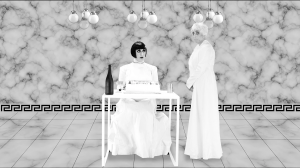By ETTY GROSSMAN
It was during the night of March 7, 1993, when Jessica Mitrani discovered what she wanted to do for the rest of her life.
It had been an intense day. Jessica woke up at 6 a.m. to make it to her 8 a.m. law class at Universidad del Norte in Barranquilla, Colombia.
While getting to her car, she dropped her everyday morning coffee all over her dress, therefore she was late to class.
As if that weren’t enough, Rodolfo Burgos, her criminal law professor, decided to talk about women rights during class, which at the time were very limited.
“That day we talked about many laws, however, there was one that caught my attention and I couldn’t get it out of my mind,” said Mitrani. “It said that if a man rapes a woman and then asks her to marry him, the rape is not valid or it is forgiven.”
She was so frustrated about this idea that, immediately, she tried to articulate a new law that would void the previous one, but she couldn’t. “There is when I realized that written words weren’t my thing,” she said. “I wasn’t able to write a new law but I could express my discomfort through drawings, images, short stories and theater.”
And this is how she learned she should be an artist.
Even her mother, Elsie Mitrani, knew that law wasn’t her thing. “When she told me she was going to study law, I freaked out,” she said. “Not because I thought she wouldn’t be able to, but because since she was a kid she kept asking me very philosophical questions and I was completely sure that she would end up being a female version of Jean-Paul Sartre, one of her favorite existentialist philosophers.”
She started to express herself through short stories, but this wasn’t enough so she decided to recreate them in a visual and palpable version, and that’s how she became the visual artist she is today. For those who doesn’t know much about her, Jessica Mitrani is a Colombian-born, New York-based artist whose work span performance, sculpture, film and video. Her latest work “Traveling Lady” ended up being a novelty in the art’s world because the piece included every art form Jessica is familiar with.
Jessica Mitrani’s work has been exhibited all around the world and in May 4 she will be screening it at the Miami Film Festival. Other venues include Jeu de Paume Paris, Museum of Modern Art Bogotá, MACRO Museum Rome, Tanya Bonakdar Gallery, and White Columns in New York, the Oberhausen Short Film Festival in Germany, Hors Pistes Festival at Centre Pompidou, Paris, among others.
“The format of the work is the last thing I think about when working on a project,” said Mitrani, “but video and film are definitely the ones that I use and enjoy the most.”
Coming from a very small, conservative and male chauvinist Jewish community, existentialism and feminism have had a very strong influence in her works.
“I grew up very much as a minority: Jewish and woman,” she said while laughing. “Feminism helped me look more critically at religion and answer many questions I didn’t understand about myself.”
As an attempt to live in an egalitarian world, in 1999 when she was 31 years old, she decided to move to New York City, but as soon as she arrived, she began to understand that it was not that feminism failed, but the institutions did. Based on this theory, she decided to investigate how the social and aesthetic construction of femininity shapes identities; and by employing narrative, humor, and psychoanalytic tropes, she decided to portray the results throughout her art.
“Traveling Lady” is one of the best examples. It is a mix of live and multimedia performance. The experimental work intended to conjure the spirit of Nellie Bly, the 19th-century journalist who circled the globe in 72 days with simply one bag, whose contents included a dressing gown, a flask and a jar of cold cream, in order to beat the challenge faced by Jules Verne’s character.
“With ‘Traveling Lady’ I wanted to explore and explode many feminine archetypes and stereotypes with surreal doses of humor,” said Mitrani. “I think humor is the only way for us to look at the craziness of the world; it’s very important to make fun of oneself and our society, otherwise everything would be unbearable.”
Spanish actress Rossy de Palma is the protagonist of the whole work; she plays several traveling ladies, who wrestle with sexism, harmful inner voices and the pressure to look young and pretty while wearing high fashion clothing.
“The project appealed to me because of its content; it is about women’s freedom, no boundaries, no fears, no frustrations,” said de Palma. “Jessica has an amazing imagination, I love her universe and her funny way to see art.”
“I admired her as an artist and respect her as a director,” she continued. “Her work is very instinctive; kindness, compassion, and empathy are the feelings that really touch other people, and Jessica expresses them in a perfect way.”
Although Mitrani’s project has traveled around the world, it came to Miami only until last year. Her solo exhibition was exhibited at the Art Basel and also at Wynwood’s new media exhibition and project space: The Screening Room.
At this multi-disciplinary space, dedicated to the motion picture, which includes video art, exhibitions, film workshops and lectures, Mitrani presented a reimagined “Traveling Lady” as a site-specific installation.
A selection of videos was projected onto three surfaces: A long curved screen with Rossy de Palma as the traveling lady; a suspended canvas bag, and an eight-foot-tall coat illuminated by patterns, colors and textures evoking a voyage around the world.
The owner of The Screening Room, Rhonda Mitrani who carries the artist last name but is not related to her, was so amazed by the project that she thought it would have been a mistake to pass up the opportunity to exhibit something in Miami that spoke to both the visual art and the film-making community.
“Jessica Mitrani is a courageous, beautiful, funny and talented filmmaker and multi-media artist; Rossy de Palma is an icon, both of them pioneers in their practice,” said Rhonda Mitrani. “Also, I considered the work was fresh for Miami because it was a hybrid between conceptual video art and narrative film-making, things that result uncommonly for the majority of the Miamians.”
At times, “Traveling Lady’s” message is a giddy psychedelic swirl of hypnotic splendor, at other times it just doesn’t make sense at all. It sounds confusing but this is exactly what the artist was looking for. “My works don’t have a concrete or absolute meaning; I’m not hoping the viewers to learn a specific thing,” said Mitrani. “I just want them to experience new emotions, discover new sensations and overall I want them to feel joy.”
Even though she denies it, she is a perfectionist. “It takes her a lot of time to find out what she wants,” said Elsie Mitrani, her mom. “But once she is sure about it, there’s nothing you can do to stop her; and that’s what I’m most proud of: her persistence.”
In a world full of creative minds, Jessica Mitrani stands out; not only for her Jew ‘fro and eccentric style but also because of her PP: Pussy Power. She is always supporting and collaborating with projects that have to do with women. Today she is starting a project in Brazil, which involved two of her passions: women and arts.
“I don’t like titles like ‘women in film’ or ‘a feminist artist’ anymore because we should not have to be singled out as this “other” category,” said Rhonda Mitrani. “But like so many other minorities out there, there is still a big cause to be fierce for and with all of the political chaos that is happening now, the feminist voice that we hear in Jessica Mitrani’s Traveling Lady is in a perfect timing.”


